Edit TM settings
A TM settings profile tells memoQ how to get matches from translation memory. This means two things:
- Match thresholds. These are two numbers: One of them sets the minimum match rate of any match that memoQ shows. The other tells memoQ what counts as a good match. (You can pre-translate documents with good matches or better. That's where memoQ uses this second number.)
- Penalties: A match is not always reliable. The match rate is supposed to tell how much you need to work on the translation you got. But it can actually be worse if the translation is bad or inadequate. For these cases, you use penalties - so that the match rate will be lower than memoQ originally computed.
To learn more about penalties, see the topic about editing TM settings.
You cannot edit the default TM settings. Either you need to make a copy of the default TM settings profile, or you need to create a new one.
Belongs to a project, not to a translation memory: You choose a TM settings profile for a project, not for a translation memory. If you choose a TM settings profile for a project, memoQ uses them for all translation memories in the project. Then again, in a different project, you can use different TM settings for the same translation memories.
In this window, you can edit a TM settings profile.
How to get here
Open the Resource Console. Choose TM settings. In the list, click the TM settings profile. Under the list, click Edit.
From a project: Open a project. In Project home, choose Settings. In the Settings pane, click the TM icon. [This icon is two jigsaw puzzle pieces, one orange, one blue.] In the list, click the TM settings profile. Under the list, click Edit.
From an online project: Open an online project for management. In the memoQ online project window, choose Settings. In the Settings pane, click the TM settings icon. [This icon is two jigsaw puzzle pieces, one orange, one blue.] In the list, click the TM settings profile. Under the list, click Edit.
Can't edit default TM settings: There is a default TM settings profile that memoQ uses for new projects - unless the project template specifies another one. To change the default settings, you must clone (copy) them first. To clone a TM settings profile: Select it in the list. In Resource Console, click Clone. In a project, click Clone/use new. memoQ makes a copy of the T? settings profile. If you're in a project, memoQ also starts using it. Then you can select the clone and click Edit.
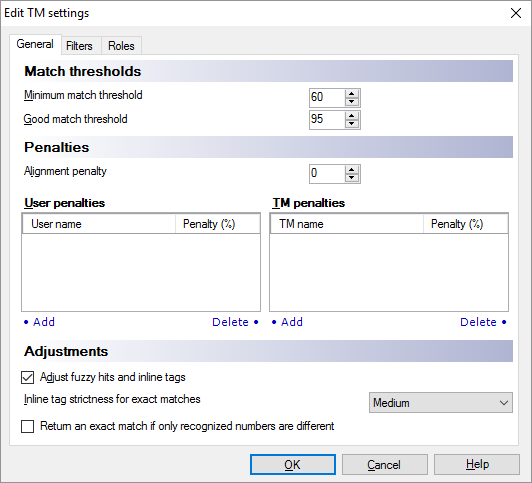
What can you do?
You can choose what matches you want to see. You can differentiate among users and LiveDocs corpora if you believe some are more reliable than others.
You can also get rid of some matches by setting conditions for descriptive fields of TM entries or entire translation memories.
Finally, you can choose to prefer matches from some roles (for example, Reviewer 2) over others (for example, Translator) - again, through penalties.
Normally, a match must be over 60% to appear at all; and over 95% to show up as a good match. In fact, 95% or above marks a match where the text is the same as in the document, but the tags, the punctuation, the spaces, and the numbers may be different.
You can choose different thresholds. Use the two number boxes at the top of the General tab.
- To set the minimum match rate for segments that memoQ returns at all: Change the percent value in the Minimum match threshold number box. memoQ doesn't return any matches that don't have this match rate or higher.
- To set the minimum match rate for segments to return as a good match: Change the percent value in the Good match threshold number box.
To make sure you get good or exact matches only: Use Pre-translate to insert the matches. In the Pre-translate and statistics window, under Lookup, click the Good match radio button.
Penalties mean that you take away a few percentage points from matches that come from certain translation memories or from certain users. You do this when the contents of a translation memory is less reliable than others, or when you have doubts about the translations coming from a certain user or another.
To set up a penalty for a user:
- Under User penalties, click Add. The New user penalty window appears:
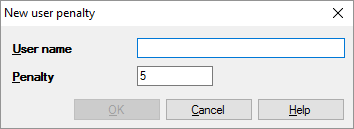
- In the User name box, type the name of the user. You can't choose from a list of users. The TM settings profile doesn't know about the actual translation memories it's used with. For a project, you choose both the translation memories and the TM settings profiles independently from each other.
- In the Penalty box, type the number of points you want to take away when the penalty is applied. For example, if the translation memory returns a match of 80% but from this user, and the penalty is 5, memoQ will show a match rate of 75%.
To delete a penalty: Click it in the User penalties box. Under the list, click Delete.
To set up a penalty for a translation memory:
- Under TM penalties, click Add. The New TM penalty window appears:
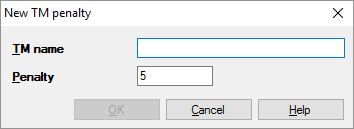
- In the TM name box, type the name of the translation memory. You can't choose from a list of corpora. The TM settings profile doesn't know about the actual LiveDocs corpora it's used with. It's possible that the TM settings profile is on a memoQ server, and you use it with translation memories from your own computer.
- In the Penalty box, type the number of points you want to take away when the penalty is applied. For example, if the translation memory returns a match of 80% but it's from this translation memory, and the penalty is 5, memoQ will show a match rate of 75%.
To delete a penalty: Click it in the TM penalties box. Under the list, click Delete.
A translation memory can have a lot of descriptive fields that tell a lot about the translation memory itself and about each entry. You can filter matches (entries) based on these descriptive fields.
You have strict filters and soft filters:
- Strict filters discard a match (a translation unit from a TM) that matches the conditions. This translation unit will not appear on the Translation results list in the translation editor.
- Soft filters take away points from a match that matches the conditions. This is the same kind of penalty you also use for users and TMs. For example, if there is a 100% match but it matches the conditions of a soft filter that specifies a 4% penalty, memoQ will show a 96% match.
To set up filters, use the Filters tab:
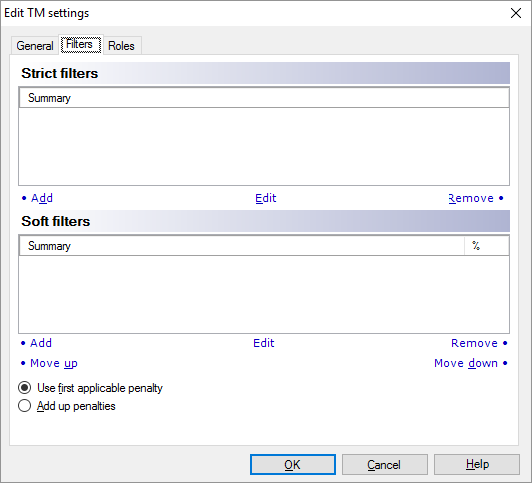
To set up strict filters:
- To add a strict filter: Under Strict filters, click Add. The Filter properties window opens. Set up the filter conditions there. Click OK.
To learn how to set up filter conditions: See the Help topic about the Filter properties window.
- To modify a strict filter: Select it in the list. Click Edit. The Filter properties window opens, with the existing filter conditions filled in. Make changes there. Click OK.
- To remove a filter: Select it in the list. Click Remove.
To set up soft filters:
If the translation unit matches more than one soft filters, memoQ can either add up the penalties, or apply the penalty for the first matching soft filter – this is your choice.
- To add a strict filter: Under Soft filters, click Add. The Filter properties window opens. Set up the filter conditions there. You can also set the penalty points in the Filter properties window. Click OK.
To learn how to set up filter conditions: See the Help topic about the Filter properties window.
- To modify a soft filter: Select it in the list. Click Edit. The Filter properties window opens, with the existing filter conditions filled in. Make changes there. Click OK.
- To remove a filter: Select it in the list. Click Remove.
If the translation unit matches more than one soft filters, memoQ can either add up the penalties from all matching filters - or apply the penalty from the first soft filter that matches the translation unit. You can choose:
- If you're using the first applicable penalty: Click the Use first applicable penalty radio button. In this case, the order of soft filters is important. memoQ processes the soft filters from top to bottom. To change the order of the soft filters, move each of them up or down in the list. Select a soft filter to move. Click Move up or Move down to move it in the list.
- To apply all the penalties from every matching filter: Click the Add up penalties radio button. In this case, the order of soft filters doesn't matter.
Translation memories can store the role of the user who confirmed a translation unit for the last time. If the role is saved, the TM knows if the confirming user is a Translator, a Reviewer 1, or a Reviewer 2. You can choose to prefer matches that come from a Reviewer 2 over matches that are saved by a Translator.
To do this, use the settings on the Roles tab:
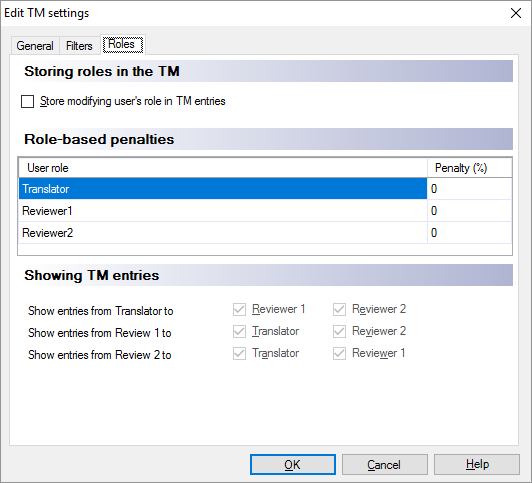
To make sure the user roles are stored in the TMs of the project: Under Storing roles in the TM, check the Store modifying user's role in TM entries check box. memoQ will save the users' role whenever a translated segment is confirmed. You need to check this check box before you can change any settings in the Roles tab.
- To apply penalties to certain roles: Under Role-based penalties, there is a list of the three user roles: Translator, Reviewer1, Reviewer2. Each user role can have a penalty. Normally, it's 0%. To change the penalty: Click the number under Penalty (%), and type another number. It makes sense to use a penalty for the Translator role.
- To choose who can see what: Under Showing TM entries, you can choose if entries from each user role are shown to users in any other roles. For example, you can decide that Reviewer 2 mustn't see matches coming from a Translator. To do that: Next to Show entries from Translator to, clear the Reviewer 2 check box. Check or clear check boxes to adjust the visibility of matches between roles.
If the differences between the document segment and the translation memory match are mainly numbers and inline tags, memoQ can insert a translation where the numbers and the tags are changed accordingly.
If you don't want memoQ to adjust matches: At the bottom the General tab, clear the Adjust fuzzy hits and inline tags check box.
Normally, memoQ returns an exact match only if the inline tags are exactly the same in the translation memory and in the project document. But you can change this. On the General tab, choose a setting from the Inline tag strictness for exact matches drop-down box.
This dropdown specifies how much memoQ tolerates differences between the document segment and the LiveDocs match. You can choose between Strict, Medium and Permissive. Inline tag strictness indicates how similar the tags should be in the translation memory to the segment your are translating. Tag strictness affects the match rate.
- Permissive means that all sequences of tags are considered equivalent, and yield an exact match.
- Medium means the tags must have the same type (open/close/empty), but attributes can be different.
- Strict means that you never get an exact match if tags are not precisely the same. At first, memoQ uses this setting.
Normally, memoQ won't return an exact match even if the only differences between the translation memory match and the document segment are the numbers that memoQ recognized.
To get an exact match if this the case: Check the Return an exact match if only recognized numbers are different check box. With this turned on, memoQ will even silently adjust the numbers and report a match rate of 100% or higher if the contexts also match.
You may still need to fix tags manually: In some case, the tags don't match between the source and target segment inside the translation memory entry. In this case, memoQ can't fix the target from the tasg in the source segment. These translation units won't give you an exact match unless the source segment is identical to the segment in the document in the strictest possible sense. In other words, even with Permissive tag strictness, you'll never get an exact match that has tags that need to be fixed manually.
When you finish
To save the changes, and return to Resource Console, to Project home, or to memoQ online project: Click OK.
To use the edited TM settings profile in a project: Create a project from a template that specifies this rule. Or, create an empty project (local or online). In Project home (or in memoQ online project), choose Settings. Click the TM settings icon. In the list, check the check box of this TM settings profile. Do this before you pre-translate documents or before you start translating them.
To return to Resource Console, to Project home, or to memoQ online project, and not save changes: Click Cancel.